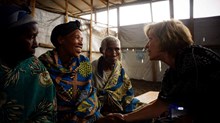An Artistic Celebration of Freedom
Christi Ziebarth always knew art would be part of her life. From playing with her mother's leftover pallets to pursuing an art degree in college, it was abundantly clear that Christi had the gift. But there was never an "a ha" moment or a point of realizing that she needed to spend her days in front of an easel. Eventually, she combined her love for the creative process and her love for children into a rewarding career as a public school art teacher.
But then it all changed.
Despite her success and early confidence, Christi experienced a profound loss of identity in her early thirties. She had become pregnant with her third child and circumstances—as well as her conviction to live each season of life to its fullest—compelled her to leave the workplace and stay home after almost a decade of teaching. On top of this, Christi developed an invasive nerve disease that left her wracked with pain and unable to fully enjoy the things she loved most—family, friends, her art.
During this time, she wrestled through what she describes as a period of mourning—grief over the loss of the person she thought she was. Christi was a Christian, a wife, and a mother. But like many, she had fallen into thinking that her career as an art teacher was interchangeable with who she was. Once removed from the professional capacity of mentoring young people through art, she hardly knew herself.
But God wasn't about to let circumstances change the calling he had for his daughter. Through this period, he led Christi on a journey to answer basic things about both herself and him. When she found herself asking "Who am I?" he responded with, "Who have I created you to be?"
In time the answer came back clearly, and Christi knew: "I am an artist."
Steps of Obedience
With this fresh understanding of herself in hand, Christi continued to develop her art. For her, it was more than self-fulfillment; it was an act of obedience. As she puts it, "Recognizing who we were created to be and living in [it]—that is obedience."
But recognizing how God has uniquely gifted you and actually following him in using those gifts for his intended purpose are not the same things. And often—as was the case in Christi's life—those first few steps are halting and terrifying. For her, it meant sitting in front of a blank piece of paper and recommitting her work to God. For ten years, Christi's "art" had been her students—their very lives were her canvases. She had poured all her creative abilities into her classroom, and apart from this, she felt lost. Christi recalls, "I didn't really have any technique or media I connected with to call my own."
So from the beginning, Christi committed to making the creative process a spiritual one, an act of worship to the One who had enabled her to praise him in her own unique way. It meant "creating [her] art for an audience of one," submitting and surrendering through the process, and letting God both shape her and use her through a new medium.
From those deeply private moments of artistic devotion, God led Christi to develop a new technique—a mosaic unlike anything she had ever seen before. Believing that this technique itself was a gift from God, she spent the next two years experimenting and developing it, eventually using it as the basis for a series of seven pieces. Each piece took upwards of 50 hours to complete, and together they communicated her spiritual journey. Christi realized that for many people the visual arts are a first language, and using them to express the work God was doing in her life was as natural as breathing. "My first piece expressed my faith that I believe God guides all … meaning, he guided my departure from teaching, the birth of my son, he allowed my disease, [and] he is guiding my hands as I create. It was a form of submission to create that piece."
Raising awareness with abolitionART
Soon after Christi began to pursue her art in whatever way God chose, a close friend returned from Ghana, West Africa, with gut-wrenching tales of child slavery, abuse, and neglect. Children as young as four were being sold to fishermen on Lake Volta and made to dive into muddy, crocodile-infested water. Most suffered malnutrition, endured daily beatings, and sometimes dove down to untangle nets never to return.
Six thousand miles away, Christi felt helpless—that kind of helplessness that sinks like a rock in the pit of your stomach. She remembers thinking, "If I can't do anything, what's the point?" And that's when God answered her with the same simple question that he had asked before, "Who are you?"
This time Christi knew how to respond. She was both a mother and an artist—a woman with the capacity to feel the brokenness of mothers who had lost their children to slavery; a woman with the compassion to be used by God to help rescue these little ones, and a woman who had the gifts to celebrate their story through the visual voice of art.
Soon God led Christi to form a partnership with two other artists to produce a traveling exhibit entitled "One Big Good: A Celebration of Freedom." Using her newly found technique that naturally lent itself to the rhythms and beauty of Africa, Christi began depicting scenes of mothers and children, village life, and the ominous boats that dotted the shores of Lake Volta. The other artists contributed textile art and contÉ portraits of the children who had been rescued. They took their message into local schools, libraries, and churches. Eventually they were displaying in galleries, exhibit halls, civic venues, and conferences—all in an effort to let their creativity tell the story of these little ones who so desperately needed help. They called their work simply "abolitionART."
A mosaic life
Over the last six years, God has lead Christi on a journey—both to find her own artistic voice and to be a voice for the voiceless. And it has happened in large part because she had the faith to answer and obey when God asked, "Who are you?" If Christi has learned anything, it's that God entrusts his children with talents and intimately guides them as they surrender to his will. As she puts it, "If you are doing what God created you to do, you are reflecting him, you are glorifying him."
Today, abolitionART hosts mosaic exhibits to raise awareness in schools and galleries all over the United States. Christi's journey and the work of abolitionART is often just like the mosaics she creates—bits and pieces that don't always make sense until the master artist places them precisely where they belong. Then as each individual piece—as each individual life—touches another, the beauty and complexity of the grand design begins to unfold.
And you realize that he had a plan all along.
Hannah R. Anderson is a freelance writer who lives in Virginia and blogs at http://www.sometimesalight.com/.
Read more articles that highlight writing by Christian women at ChristianityToday.com/Women
 Read These Next
Read These Next

 Determining PrioritiesIt’s only by saying no that you can concentrate on the things that are really important.
Determining PrioritiesIt’s only by saying no that you can concentrate on the things that are really important.
 Refugee Resettlement Isn’t a Political Issue—It’s a Humanitarian IssueIn the world’s “most dangerous place for women,” the greatest fear isn’t rape or death—it’s being forgotten. My heartbreaking experience in a displacement camp for the people of Congo.
Refugee Resettlement Isn’t a Political Issue—It’s a Humanitarian IssueIn the world’s “most dangerous place for women,” the greatest fear isn’t rape or death—it’s being forgotten. My heartbreaking experience in a displacement camp for the people of Congo.








 Homepage
Homepage